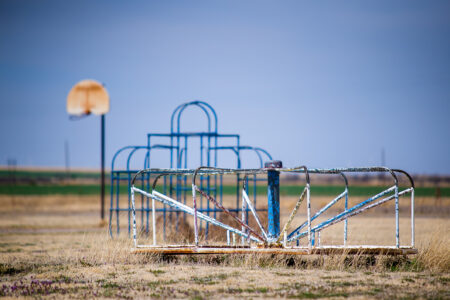Share On Social!
Community, school, and city officials worked together to develop a shared use agreement to use school grounds to create a community park at Sky Harbour Elementary School in San Antonio, Texas, with a playground, exercise equipment, trails, and an amphitheater that is open after school hours. The effort illustrates how city officials, a non-profit organization, a school district, a P.E. coach, students, parents, and members from the community can work together to bring important improvements to the physical environment that can increase local options for physical activity. Each of these stakeholders saw the need for more play space in the community and supported a shared use agreement to guarantee access to Sky Harbour’s recreational facilities on school grounds after school hours. From start to finish, each group played a vital role in assuring that the children of this underserved community would have a safe, inviting environment to play.
EMERGENCE
Awareness: San Antonio City Council member Reed Williams fondly remembers taking his children to play on school playgrounds and fields as they grew up.
He just didn’t know it was against the rules.
“I [recently] was at a public library located next to a school, when I saw kids climbing over a fence to get to the school playground,” said Williams, who represents San Antonio’s 8th district. “It had never entered my mind that you couldn’t go play at the schools.”
It was only then that he realized that fields, playgrounds, and trails on school grounds were off limits to children and families during after-school hours. A lack of physical activity options can reduce children’s opportunities to get enough physical activity to maintain a healthy lifestyle.
He decided to find a way to open up schoolyards to children during after school hours.
“Clearly it was something that was needed,” Williams said.
Learn: Many children in San Antonio, and other Latino communities like it, live in areas with little or no access to safe, quality options for physical activity.
One way to provide more play space for children is to take advantage of existing facilities, such as school playgrounds, and to allow facilities to remain open to the public during after school hours, through a shared use agreement.
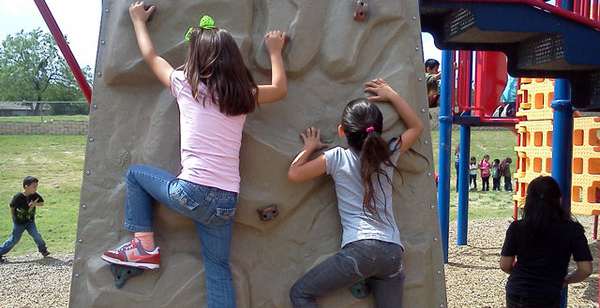
Ideally there should be a park within walking distance of every house; however there is not enough land for this to be possible,” said George Block of San Antonio Sports. “Probably 99% of elementary schools in every neighborhood have an outside area or a gym which can be used by the community.”
So why not use school facilities?
In fact, officials from the City of San Antonio’s Park and Recreation Department had discussed establishing shared use agreements with schools to open school facilities after hours, but there were “difficulties” getting buy-in from school districts, Williams said.
Williams tried to think of alternate ideas. He had heard about the SPARK parks program in Houston, but hadn’t really considered it as an option in San Antonio. SPARK parks, a non-profit organization based in Houston, takes a two-pronged approach to increase local physical activity options: 1) transform school playgrounds in underserved areas into imaginative parks; and 2) establish shared use agreements to ensure that parks are available to the community during after school hours.
After seeing a SPARK park for himself, Williams decided to try to bring a similar initiative to San Antonio.
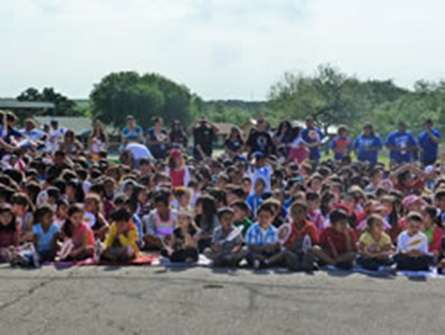
Frame Issue: Williams and his staff “decided to take the health angle” as a way to pitch the idea locally, Williams said.
So he met with representatives from the San Antonio Metropolitan Health District (Metro Health) to see how they could bring SPARK parks to San Antonio. Metro Health organized a meeting and invited Kathleen Ownby, executive director of SPARK parks in Houston, to speak about SPARK to non-profit organizations in San Antonio.
SPARK parks programs require management by a local non-profit organization. City officials asked San Antonio Sports (SAS), which has experience in organizing sporting events and athletic programs for children, to take on the role of developing and managing a SPARK parks program for San Antonio.
Where would the SPARK park program go locally?
Although outside his council district, Williams saw a great need in San Antonio’s Southwest Independent School District (SWISD), where there are few community parks and few options for physical activity.
“A lot of [kids] don’t have the transportation to go out of their neighborhood to go and visit a fitness park or take a walk that would be safe,” said Sky Harbour Principal Marina Avila, according to a KENS-TV report.
So Williams teamed with City Council member Rey Saldaña, whose constituency includes SWISD. Williams agreed to use some of his district’s funds to help kick-off the development of the city’s new SPARK parks program.
They targeted SWISD’s Sky Harbour Elementary as the first school to be a SPARK park. More than 95% of the students from Sky Harbour come from economically disadvantaged homes and 98% are Hispanic.
See the ordinance that allowed $50,000 in funds from Metro Health’s Communities Putting Prevention to Work Grant (CPPW) grant to be put toward the development of the San Antonio SPARK park program. On page 5 read about the duties that SAS agreed to fulfill, in order to receive this money.
DEVELOPMENT
Education: SAS would act as the catalyst between schools and the city, to get more joint usage out of schoolyards. SAS already had a good working relationship with SWISD because SAS managed some of the district’s after-school sports programs, said Victoria Gaeta of the SWISD Office of Community Education.
SAS approached SWISD’s superintendent with the idea of bringing a new park to the school, in exchange for keeping school grounds open during after school hours. The Superintendent expressed the district’s willingness to participate in the program; however, the district would require that plans and a budget be developed before formalizing any agreement.
A transformative park can cost up to $300,000, Block said, so SAS worked with SWISD’s Facilities Director Eduardo Garcia to create innovative ways to fund a SPARK park at Sky Harbour.
To minimize project costs, Garcia would determine what components of the project could be completed by district employees. The rest of the construction would be completed by independent contractors. The city contributed $49,899 toward the SPARK park, half of which came from the District 4 office and half which came from District 8. With $49,899 from the city to work with, SAS searched for additional grants and sought donations from local businesses. Meanwhile, Sky Harbour staff and parents were planning to get busy and raise their own share of funds for the park.
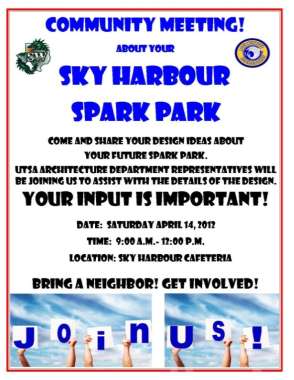
Mobilization: Consuelo Rodriguez, a P.E. teacher/coach at Sky Harbour, was charged with reaching out to the community.
At a PTA meeting Rodriguez told parents: “I had always envisioned a park like this.”
Children also did their part, too. Before park ideas were presented to parents, students submitted sketches of what they would like their dream playground to look like (part of the SPARK parks process). These sketches were then passed on to architecture students the School of Architecture at the University of Texas at San Antonio (UTSA), who were brought on board to contribute to the design process. This would help off-set costs associated with planning and architecture fees, while also giving architecture students the experience of working with a client.
To participate in the SPARK program, the franchise requires that the school and local community be involved in raising at least $5,000 in funds for the park’s development. “We had plate sales, festivals, movie nights, and also asked for donations,” Rodriguez said. “The parents helped a lot in facilitating the plate sales.” About six parents were directly involved in the process.
“Coach Rodriguez was like the pied piper of that community. They love her,” Gaeta said.
Debate: Having struggled in the past with getting schools to buy into the idea of signing shared use agreements, SAS decided to take on a new approach and urged Sky Harbour school officials decide the terms of the agreement, with the caveats the school must be responsible for maintaining park grounds, and the facilities remain open during after-school hours, weekends, and over the summer.
The district wanted a fence between the school building and the park, and wanted the park to be opened during reasonable hours (until dusk). At neighborhood meetings, most of the community expressed their support for a community park at the school; however, some were concerned about the neighborhood’s safety and about the possibility of vandalism to the park. The district thus agreed to provide security for the area.
ENACTMENT
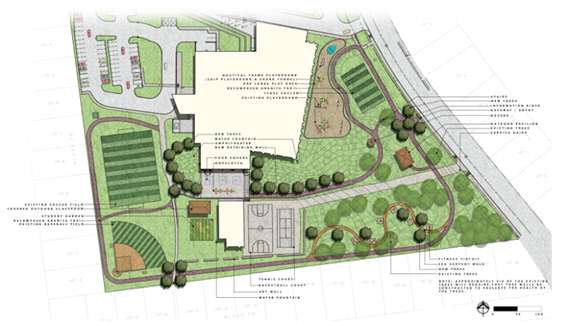
Activation: Professors, graduate students from the architecture department at UTSA, and Ed Garcia led “charettes”—neighborhood visioning sessions—to allow local residents to participate in giving input to the design team. “We went door-to-door to hand out flyers to those who lived adjacent to the school,” Coach Rodriguez said. “We wanted as many people to come to the charette as we could get, that’s why we hand delivered the flyers.” Designs created by UTSA architecture students were presented to parents and members of the school board. Ultimately a decision was reached to adopt a nautical-themed design for the SPARK park.
After seeing the community’s overwhelming support for the development of a community park at Sky Harbour, those residents who were at first skeptical realized it was something worth having in their community. “I approached them and said something great is happening in our neighborhood,” Coach Rodriguez said. The community’s support and efforts to raise more than $5,000 in funds for their new park further encouraged school officials to support the idea of entering into a shared use agreement with the city.
Frame Policy: Because SAS and city officials wanted more SPARK parks for the city, three school districts (NEISD, SAISD, SWISD), SAS, and the City of San Antonio entered into a tri-party funding agreement, which would support the development of the Sky Harbour SPARK park and two others.
The Northeast Independent School District (NEISD) had its legal team develop a template for a shared use agreement with the city. Schools from other districts—like SWISD and Sky Harbour—also adopted the template for their own SPARK park shared use agreements.
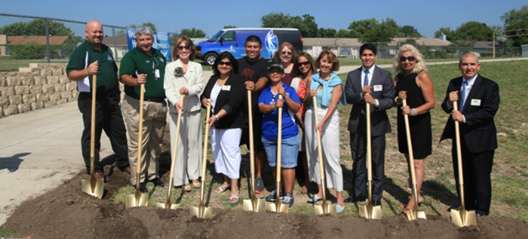
Change: On April 12, 2012, the City Council, SAS, and SWISD signed an ordinance to allow $48,899 from districts 4 and 8 to be used for the development of Sky Harbour’s SPARK park.
Read this news article about how the SPARK program came to San Antonio.
View the video featured in this news story to hear what school officials and city council member Rey Saldaña had to say about Sky Harbour’s SPARK park.
IMPLEMENTATION
Implementation: A groundbreaking ceremony for the SPARK park at Sky Harbour was held on June 1, 2012.
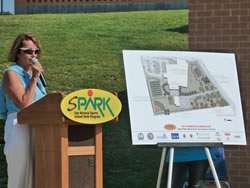
As of January 2013, Phase I of the project was complete. Exercise equipment, benches, picnic tables, and a 1/3 mile walking trail were created. A 700-seat amphitheater and community garden beds, where children will tend vegetable gardens, will be built during Phase II. The entire project is expected to be complete by the end of 2013. Although construction is still underway, the community is already using the park.
“It has transformed the entire campus,” and even the teachers are motivated to stay active, Gaeta said.
Rodriguez said students say that their families have started using the track after school.
A few months after the ground breaking ceremony, District 8 found a way to provide $128,400.67 more in funds for the completion of the Sky Harbour’s SPARK park.
Read more about the additional funds in the following ordinance.
Equity: Progress on the SPARK park at Sky Harbour has other schools in other districts excited.
“Everyone is clamoring for them,” Block said. “If everything works out as we predict it will, it’s going to be a great opportunity and a great launching pad for the City of San Antonio to do more SPARK parks,” added Southwest Independent School District superintendent Dr. Lloyd Verstuyft.
Currently, 11 SPARK parks are at various stages of development across the city. The city has a goal of creating 100 new parks within 10 years.
Sustainability: The community is taking ownership of the process. Garden beds will be installed at the Sky Harbour SPARK park and students will play a role in maintaining the park.
“The district has worked hard to get parental involvement because it [healthy lifestyle change] starts at home,” Gaeta said.
Students, parents, educators, and civic leaders all played a role in bringing this new park to their community. Although the shared use agreement has a lifespan of only 5 years, “the hope is that there would be so much community usage of the SPARK park, that the schools wouldn’t even consider closing it,” Block said.
“There’s a lot I still envision for this park,” Rodriguez said. “In the future I would like to start a fitness club to get more kids to come out after school.”
Additional links:
Since the groundbreaking at Harbourside Elementary, groundbreaking of SPARK parks at other locations, like Camelot elementary, have occurred in San Antonio.
This success story was produced by Salud America! with support from the Robert Wood Johnson Foundation.
The stories are intended for educational and informative purposes. References to specific policymakers, individuals, schools, policies, or companies have been included solely to advance these purposes and do not constitute an endorsement, sponsorship, or recommendation. Stories are based on and told by real community members and are the opinions and views of the individuals whose stories are told. Organization and activities described were not supported by Salud America! or the Robert Wood Johnson Foundation and do not necessarily represent the views of Salud America! or the Robert Wood Johnson Foundation.
ABOUT THE PROGRAM
Salud America! The RWJF Research Network to Prevent Obesity Among Latino Children is a national program of the Robert Wood Johnson Foundation. The program aims to educate researchers, decision-makers, community leaders, and the public in contributing toward healthier Latino communities and seeking environmental and policy solutions to the epidemic of Latino childhood obesity. The network is directed by the Institute for Health Promotion Research at the University of Texas Health Science Center at San Antonio.
For more information, visit http://www.salud-america.org.
By The Numbers
33
percent
of Latinos live within walking distance (<1 mile) of a park
This success story was produced by Salud America! with support from the Robert Wood Johnson Foundation.
The stories are intended for educational and informative purposes. References to specific policymakers, individuals, schools, policies, or companies have been included solely to advance these purposes and do not constitute an endorsement, sponsorship, or recommendation. Stories are based on and told by real community members and are the opinions and views of the individuals whose stories are told. Organization and activities described were not supported by Salud America! or the Robert Wood Johnson Foundation and do not necessarily represent the views of Salud America! or the Robert Wood Johnson Foundation.


